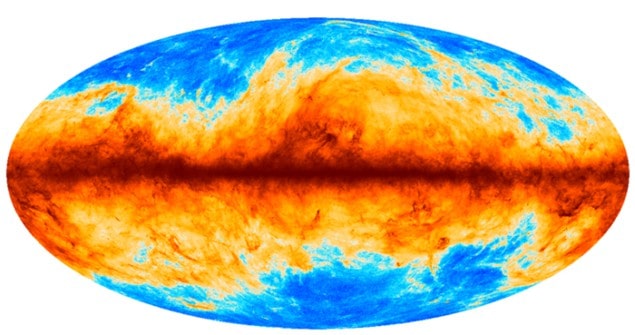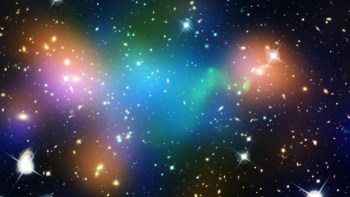
Physicists in the UK and the US have shown how to use one kind of diffuse cosmic radiation – the cosmic infrared background (CIB) – to create a better map of potentially very important variations in another – the cosmic microwave background (CMB). The researchers say that their work, which involves reversing the effects of gravitational lensing, will aid in the discovery of inflationary phenomena known as primordial gravitational waves, should they exist.
The CMB is ancient microwave radiation that fills the universe. It was released a few hundred thousand years after the Big Bang when nuclei and electrons combined to form neutral atoms. Although its temperature is almost entirely uniform, it does contain patches that are slightly warmer and cooler (by a few ten-thousandths of a degree) than its mean temperature of 2.725 K. Those fluctuations have been studied in great detail by successively more powerful space observatories. These results provide strong support for the theory of cosmic inflation – which describes a period of the very early universe – and give precise values for the relative abundance of dark matter and dark energy in the universe.
Today, astronomers are very keen to study variations in the CMB’s polarization. In particular, scientists want to detect “B modes”, which are distinctive variations in the direction of the CMB’s polarization axes around hot and cold spots that are neither concentric with the spots nor create radii extending away from them. These B modes would point to the existence of hypothetical primordial gravitational waves, which would reveal exactly when the universe went through its inflationary burst of expansion.
Contamination woes
In 2014, the BICEP2 collaboration announced to great fanfare that it had observed these B modes in data from a radio telescope it operated at the South Pole, but results subsequently released by the European Space Agency’s Planck mission showed that the signal was instead probably due to emission at microwave frequencies from galactic dust. According to Patricia Larsen of the University of Cambridge, future experiments should be able to largely overcome this problem by observing the CMB at multiple wavelengths and thereby filter out the contribution from the dust. But, she says, another, “more fundamental”, problem will remain – contamination of the data by gravitational lensing.
Gravitational lensing occurs when light from a distant source is bent by a nearer, massive object. It has the effect of slightly shifting the relative position of features within the CMB, which can be useful in that it gives information about how structures formed in the early universe. Lensing also turns what is known as E-mode polarization – involving concentric and radial polarization variations – into the B-mode kind, thereby masking B-mode signals from the primordial gravitational waves.
In the latest work, Larsen and colleagues have shown how to significantly reduce this lensing effect using the CIB – infrared radiation generated by galaxies that are so far away that they cannot be resolved individually by telescopes. Such galaxies are at about the right distance to lens the CMB, and therefore the spatial distribution of their infrared emissions should provide a strong indication of how CMB lensing varies across the sky. This information can then be used to subtract the lensing effect from the primordial fluctuations.
Dusty emissions
However, dust in the Milky Way also emits copious amounts of radiation in the infrared. What Larsen and colleagues have done is to take advantage of the fact that dust emission is highly correlated at different infrared frequencies. Using observations made by Planck at two such frequencies, they were able to largely remove the galactic contamination of the CIB.
Unfortunately, the researchers didn’t have access to CMB polarization data with a high enough signal-to-noise ratio for their purposes. However, they did show that they could remove about 20% of the lensing effect from Planck CMB temperature maps – in line with theoretical predictions. Larsen reckons that that percentage could be higher for B-mode measurements, and that more refined “delensing” techniques could become available. “There are potentially better ways of doing this and we will be looking into that,” she says. “But the point is that nobody was confident that you could remove the dust well enough to do this in the first place.”
Marc Kamionkowski of Johns Hopkins University in the US, who was not involved with the current work, agrees that other delensing techniques might prove more powerful in the future. But he says it is important that scientists have for the first time backed up theoretical predictions of delensing with an analysis of real data. “With this paper, these guys have earned bragging rights,” he says.
“Best way forward”
Likewise, Gilbert Holder of McGill University in Canada says that the CIB is probably not correlated closely enough to the distribution of large-scale structure in the universe for this type of delensing to “unlock the full discovery potential of future B-mode searches”. But he believes that the CIB approach is “the best way forward with the current generation of experiments”.
Larsen points out that scientists do not know just how small any B-mode signal could be. But she nevertheless estimates that removing around half of the lensing signal will “roughly double” the chances of detecting primordial gravitational waves. “A lot of money goes into these experiments,” she adds. “So we really need to try and create the best possible chance of detecting the signal.”
A paper describing the research has been uploaded to the arXiv server.



